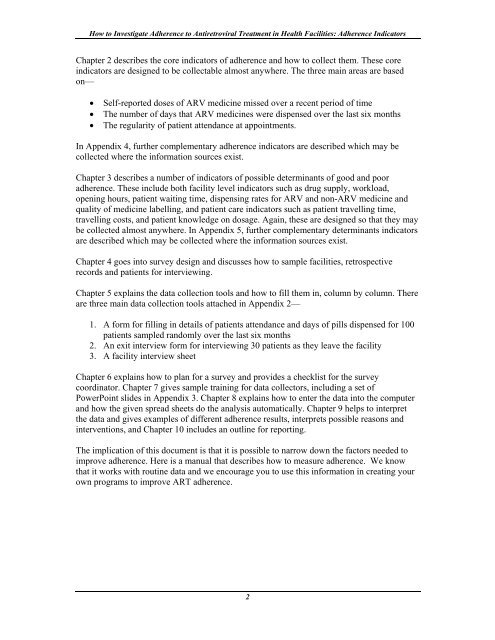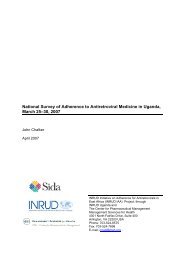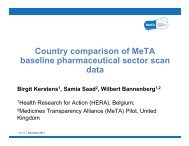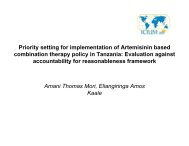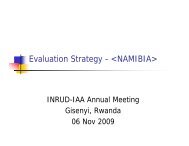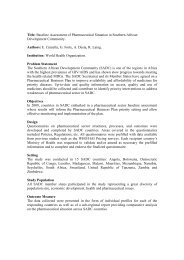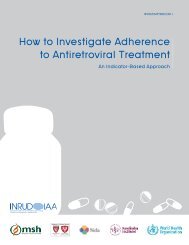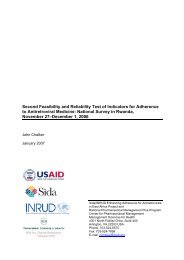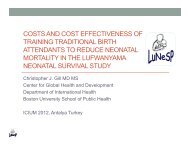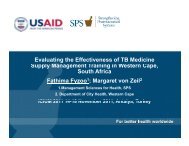How to investigate Adherence to Antiretroviral Treatment ... - INRUD
How to investigate Adherence to Antiretroviral Treatment ... - INRUD
How to investigate Adherence to Antiretroviral Treatment ... - INRUD
You also want an ePaper? Increase the reach of your titles
YUMPU automatically turns print PDFs into web optimized ePapers that Google loves.
<strong>How</strong> <strong>to</strong> Investigate <strong>Adherence</strong> <strong>to</strong> <strong>Antiretroviral</strong> <strong>Treatment</strong> in Health Facilities: <strong>Adherence</strong> Indica<strong>to</strong>rs<br />
Chapter 2 describes the core indica<strong>to</strong>rs of adherence and how <strong>to</strong> collect them. These core<br />
indica<strong>to</strong>rs are designed <strong>to</strong> be collectable almost anywhere. The three main areas are based<br />
on—<br />
• Self-reported doses of ARV medicine missed over a recent period of time<br />
• The number of days that ARV medicines were dispensed over the last six months<br />
• The regularity of patient attendance at appointments.<br />
In Appendix 4, further complementary adherence indica<strong>to</strong>rs are described which may be<br />
collected where the information sources exist.<br />
Chapter 3 describes a number of indica<strong>to</strong>rs of possible determinants of good and poor<br />
adherence. These include both facility level indica<strong>to</strong>rs such as drug supply, workload,<br />
opening hours, patient waiting time, dispensing rates for ARV and non-ARV medicine and<br />
quality of medicine labelling, and patient care indica<strong>to</strong>rs such as patient travelling time,<br />
travelling costs, and patient knowledge on dosage. Again, these are designed so that they may<br />
be collected almost anywhere. In Appendix 5, further complementary determinants indica<strong>to</strong>rs<br />
are described which may be collected where the information sources exist.<br />
Chapter 4 goes in<strong>to</strong> survey design and discusses how <strong>to</strong> sample facilities, retrospective<br />
records and patients for interviewing.<br />
Chapter 5 explains the data collection <strong>to</strong>ols and how <strong>to</strong> fill them in, column by column. There<br />
are three main data collection <strong>to</strong>ols attached in Appendix 2—<br />
1. A form for filling in details of patients attendance and days of pills dispensed for 100<br />
patients sampled randomly over the last six months<br />
2. An exit interview form for interviewing 30 patients as they leave the facility<br />
3. A facility interview sheet<br />
Chapter 6 explains how <strong>to</strong> plan for a survey and provides a checklist for the survey<br />
coordina<strong>to</strong>r. Chapter 7 gives sample training for data collec<strong>to</strong>rs, including a set of<br />
PowerPoint slides in Appendix 3. Chapter 8 explains how <strong>to</strong> enter the data in<strong>to</strong> the computer<br />
and how the given spread sheets do the analysis au<strong>to</strong>matically. Chapter 9 helps <strong>to</strong> interpret<br />
the data and gives examples of different adherence results, interprets possible reasons and<br />
interventions, and Chapter 10 includes an outline for reporting.<br />
The implication of this document is that it is possible <strong>to</strong> narrow down the fac<strong>to</strong>rs needed <strong>to</strong><br />
improve adherence. Here is a manual that describes how <strong>to</strong> measure adherence. We know<br />
that it works with routine data and we encourage you <strong>to</strong> use this information in creating your<br />
own programs <strong>to</strong> improve ART adherence.<br />
2


